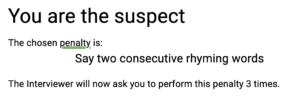For my first critical play, I played Robot Interrogation, which is an online version of the game Inhuman Conditions, created by Tommy Maranges and Cory O’Brien. This online version gives you the option to either play with a friend over video chat or play in the same room. I chose to play with my roommate in the same room, which was more true to the original analog version of the game. The game is an interesting mix of roleplaying and social deduction. I think the target audience for this game is players who enjoy other social deduction games such as Mafia, Werewolf, and Secret Hitler, but would also seek out games that involve roleplaying and an interesting twist. After playing the first game with my roommate, it became clear that this game is probably meant to be played by two people who know each other quite well, such as family members, close friends, or couples.
Notably, this game can only be played by two players. The detailed rules suggest that the game can also be played by more than two players, however it seems that only two entities are really interacting with the game at a time, so others would be spectating or waiting their turn while the game is being played. The game starts off by assigning each player to a role: one is assigned to be the interviewer, and the other is assigned to be the suspect.


The premise of the game is that the interviewer is trying to determine if the suspect is a robot, while the suspect is either a human trying to prove they are human, or a robot trying to kill the interviewer. This creates an interesting dynamic as the interaction pattern of the game changes based on whether the suspect is a human or a robot. The outcome of the game is not binary if the suspect of a human; both players win if the interviewer correctly identifies the suspect as a human, and both players lose if the interviewer incorrectly identifies the suspect as a robot. Therefore the game can be considered co-op. In the case where the suspect is a robot, the interviewer must identify them as a robot to win, and the suspect must kill the interviewer to win. In this case the game is player vs. player.
The social deduction part of the game is present in how the interviewer must closely examine the suspect’s behavior to determine whether they are a robot or not. If the suspect is assigned to be a robot, they must behave certain ways or complete certain tasks during the interview to win. For example, a violent robot may have to successfully interrupt the interviewer several times and perform a penalty, such as swearing during the interview, before being able to kill the interviewer. A patient robot may have to only speak in the hypothetical for the entirety of the interview and still be classified as a human to win. The complex social deduction mechanics of the game seem to fit better for players who know each other well, as classifying the suspect correctly relies on noticing nuance and subtle changes in behavior and speech.
The interview lasts 5 minutes and is the interviewer’s chance to ask questions from various interview packets in order to examine the suspect’s behavior and try to determine if they are a human or a robot. If the interviewer thinks that the suspect is a robot, they can end the interview at any time and accuse the suspect of being a robot. If not, at the end of the 5 minutes, the interviewer must decide whether the suspect is a human or a robot. A few example interview questions are the following:

The end of the game, when I incorrectly classified my roommate as a robot:

My roommate and I both played each side multiple times, and played the suspect as a human, a patient robot, and a violent robot. I was surprised to find that the game ended up being a lot more funny than competitive, as we got ourselves into a lot of funny situations where the interviewer was extremely confident that the suspect was a robot due to a few subtleties in speech and behavior, only to incorrectly classify the suspect. We both had a lot of fun playing the game. The social deduction mechanics of the game made it exciting and generated a lot of laughter.
The games I know of that fall into a similar genre as this game include Mafia, Werewolf, and Secret Hitler. Although these are all social deduction games in some sense, Robot Interrogation/Inhuman Conditions was quite unique and not really like any game I had ever played before. For that reason it is hard to compare these games and claim that one is better or worse, but from a game design perspective, Robot Interrogation/Inhuman Conditions was a much more interesting concept and offered gameplay and player to player interaction in a way that I haven’t seen from other games. While this is not necessarily a negative, I would have trouble calling this game a “party game” due to the fact that it is limited to two players. If you were in a group setting, this game would probably not be the one to play. A different mode that includes a large group of players, perhaps with teams, could make this game even more exciting. Additionally, I would have liked to see more visually interesting design, although I realize that this online adaptation cannot really be compared to the original analog version of the game. If you have never played this game, I would highly recommend giving it a try, especially if you can play it with someone you know well. It is a good pick for a social deduction game-lover looking for a unique twist on social deduction!



